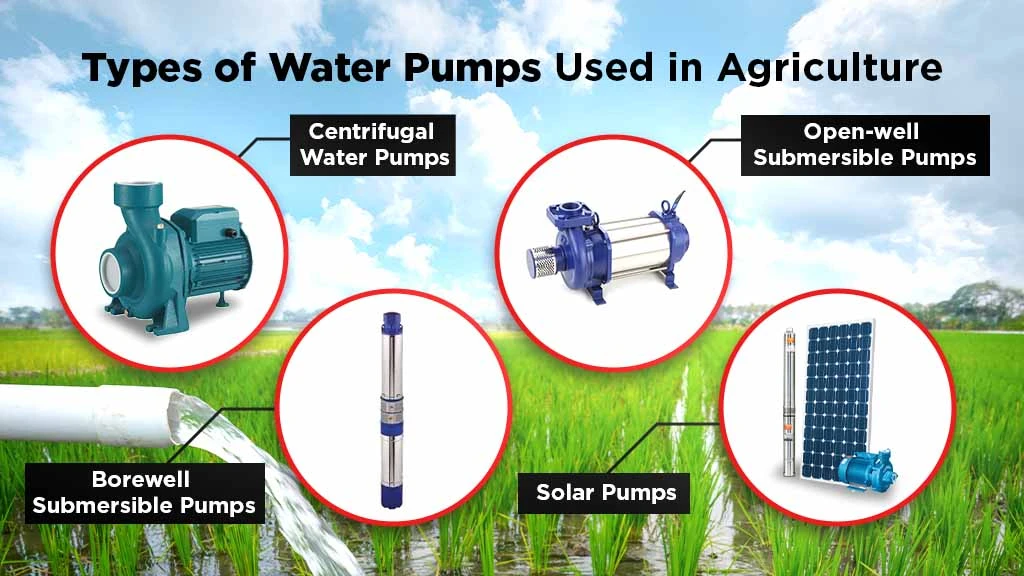How to Choose the Right Water Pump for Your Farm’s Irrigation Needs?

Water pumps are integral to Indian agriculture to overcome water scarcity and seasonal variability. These pumps ensure effective irrigation in areas where water availability is uncertain. Based on power source and working, there are mainly four types of water pumps: Centrifugal, Borewell Submersible, Open-well Submersible, and Solar. Let’s check out the function of water pumps in agriculture, along with their different types, to help you choose the most suitable pump for your farm.
Table of Contents
- Overview of Water Pumps
- What is the Function of Water Pumps in Agriculture?
- What are the Different Types of Water Pumps?
- How to Choose the Best Water Pump for Your Farm?
Overview of Water Pumps
A water pump is valuable machinery for transferring water from a water source to the desired location. It has a wide range of uses in diverse applications, ranging from industrial and residential to construction and agriculture settings. However, the significance of water pumps in agriculture cannot be stressed enough due to their direct impact on irrigation practices. They ensure crops get a suitable amount of water, which is required for healthy crop growth and high yields. A water supply pump facilitates even water distribution while saving time and manual labour.
What is the Function of Water Pumps in Agriculture?
The primary function of water pumps in agriculture is to extract water from different sources, like underground reservoirs, wells, lakes, and rivers, and supply it to agricultural fields. Crops need suitable water at the correct time, which is ensured with the help of water pumps. So, they undergo healthy growth and produce high yields. Using water pumps prevents soil degradation and maintains ideal soil moisture levels. It results in adequate distribution of nutrients in the soil. Overall, water supply pumps lead to effective irrigation that addresses challenges related to irregular rainfall patterns and droughts across the country.
What are the Different Types of Water Pumps?

There are 4 main types of water pumps: Centrifugal Water Pumps, Borewell Submersible Pumps, Open-well Submersible Pumps and Solar Pumps.
Let’s see each water pumps in detail:
Centrifugal Water Pumps
One of the most common water pump types used for agriculture is the centrifugal water pump. It can pump water from shallow wells, reservoirs, and lakes, mainly for irrigation purposes. This water pump uses a rotating impeller to move water through the pump. Water is drawn by the impeller using a centrifugal force and pass it via the discharge valve. These pumps are value for money for small and marginal farmers due to their lower initial investment. Also, they demand low maintenance as these pumps have simple construction and fewer moving parts. Centrifugal water pumps can transport large volumes of water over long distances, including higher elevations. The following is the classification of centrifugal pumps:
- Radial flow
- Axial flow
- Mixed flow
- Submersible
Borewell Submersible Pumps
These water pumps are airtightly insulated and completely submerged in groundwater. A hermetically sealed motor pumps out water in which the pump is immersed. It does not pull water but pushes water upward. This pump can lift water from deep borewells efficiently without cavitation issues. There is no need for priming as the pump is already submerged in water. These submersible pumps are best suited for continuous water delivery to keep crop cycles on schedule, which is beneficial for areas with power outages or erratic monsoons. Also, they allow access to deeper groundwater, facilitating off-season cultivation. These water pumps can easily operate across a large voltage range.
Open-well Submersible Pumps
Open-well submersible pumps are ideal for moving water from well and canals to storage tanks or farms. They are designed for working in shallow water sources. Due to their air-tight seal, they can be kept in water. These pumps do not need priming and are efficient, as the extraction of water from the source does not demand high power. The water movement in the pump is enabled by the water pressure. Also, they do not need additional cooling as they are already immersed in water. These pumps are available in both single and three-phase models and thus offer high voltage tolerance.
Solar Pumps
Photovoltaic technology is used by solar pumps to convert solar energy into electricity that operates the pumping system. It is an effective, eco-friendly alternative to pollution-causing diesel pumps. These pumps ensure a consistent water supply during dry spells that increase crop production and improve yields. It is a clean energy solution for remote areas with off-grid farms or unreliable grid power. Even though the initial investment is high for some farmers, long-term savings are high. Also, solar pumps in Indian agriculture are supported by several government schemes, including PM-KUSUM Yojana.
How to Choose the Best Water Pump for Your Farm?
It is important to choose the right water pump to experience its key benefits, like high yields, lower operating costs, and efficient irrigation.
- Check the source from which water has to be drawn. A centrifugal pump is ideal for open wells, canals, and ponds. The open-well submersible is recommended for farm ponds, sumps, and open wells. Borewell submersible pumps are best suited for borewells and deep tubewells.
- Assess power and fuel supply in your area. Diesel is widely used in off-grid farms, but it incurs fuel costs and higher emissions. Consider solar pumps for eco-friendly options. A three-phase supply is recommended for pumps with high power output.
- Evaluate your pump head requirement to ensure the pump delivers sufficient power to lift and transport water across the irrigation system. In case of an undersized head, there will be little or no flow as the pump is not able to generate a suitable force to move water.
- Determine your water discharge needs based on crops, spacing, etc, to ensure reliable irrigation. Both underwatering and overwatering are damaging to crops.
- Check your budget and choose a water pump type that is value for money for your irrigation needs.
Here’s how you can choose a water pump that ensures effective irrigation across your farm. There is different classification of pumps, including submersible pumps for deeper wells and surface pumps for shallow water sources. Also, you can choose from different power sources, including solar-powered, diesel, and electric pumps. In conclusion, water pumps are an important piece of equipment critical for modern agriculture, facing water availability and scarcity issues.
Frequently Asked Questions On Water Pumps in Indian Agriculture
1. What are the different types of pumps?
The different types of pumps in agriculture are centrifugal, borewell submersible, open-well submersible, and solar pumps.
2. Which type of pump is most commonly used?
The most commonly used pump is the centrifugal pump.
3. What are the 4 types of centrifugal pumps?
The 4 types of centrifugal pumps are radial flow, axial flow, mixed flow, and submersible pumps.


Related Blogs












